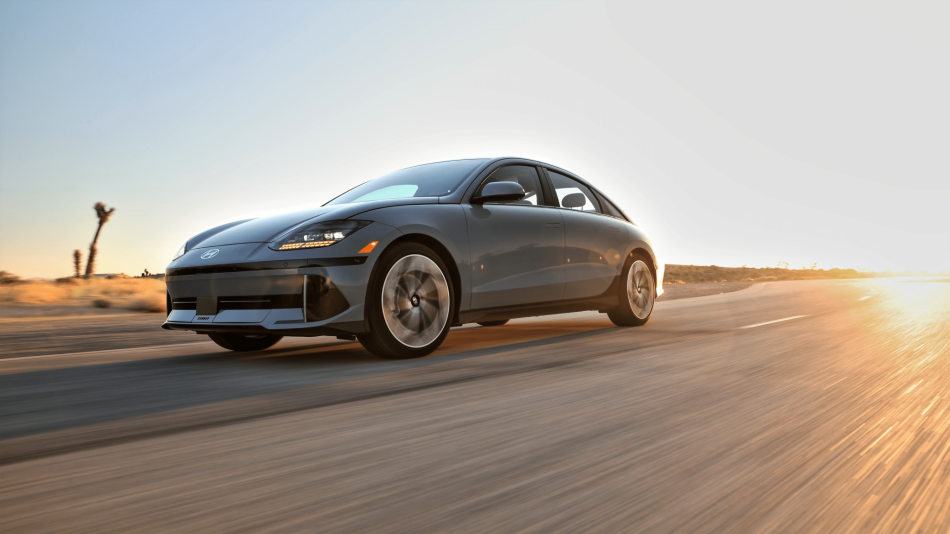Ford & Hyundai Rise to Tesla’s Challenge
Ford’s Mach E Type S can go mid-200s at spirited speeds and the Hyundai Ioniq6 is a blast to drive with direct steering
By Isaac Bouchard
Tesla blazed the path with electric cars that could actually replace those with internal combustion engines (ICE), and it seemingly took the legacy companies forever to catch up.
But now there are genuine rivals, ones that beat the Musk machines in many measures. The Ford Mach-E and Hyundai Ioniq6 are two of the most compelling. The Ford arrived first, and it’s a helluva first EV effort. Its style seems to engage a large cross-section of the public and its cabin is first-rate, with great quality and some beautiful touches, such as the swath of cloth that fronts the dash. It has less cargo room than the archrival Tesla Model Y, but is a much nicer place to spend time in — not only because of the posher trimmings but because it rides so much better. The Model Y is seemingly tuned for the track and pummels occupants without remit or seeming remorse. The Mach-E has excellent damping and smothers area road blemishes with excellence. It’s also quieter and more refined. It’s not as quick in normal guise as the Tesla, but is faster accelerating than most will ever need.

The Ioniq6 is not Hyundai’s first mainstream EV. That honor goes to the Ioniq5, whose E-GMP platform is shared across the Hyundai Group. The 6 is aimed squarely at the Tesla Model 3 sedan. Its looks are polarizing; it can be compared to everything from a VW Beetle to a riff on the Porsche Taycan — or even a 1930s Chrysler Airflow.
It’s obviously designed to cheat the wind, and it gets excellent EPA ratings and real-world range as a result. It is also a blast to drive, with direct steering, a sports sedan-worthy chassis and great ride/ handling balance. And it’s fast—Tesla fast.
The Ioniq6’s interior is almost as progressive as its exterior form, with lots of intriguing detailing and a great nighttime vibe. It is also comfortable and very roomy — except for the trunk, which is much smaller than the one in the 3.

The big question of course is whether these rivals have enough range, and the short answer is yes. The Mach-E is rated at 290 miles, and can indeed go mid-200s driven at spirited speeds. Some Ioniq6 models claim EPA numbers in the mid-300s. In AWD Limited form, with 20-inch wheels that chop off 40 miles of range, it is still rated—and capable—of doing a genuine 270 miles between charges. And, since the Genesis-Hyundai-Kia platform charges faster than anything on this side of a Lucid Air, you can add 150 miles or more in 15 minutes. Not so the Ford, whose 400-volt architecture doubles that time.
Yes, some Teslas are EPA-rated to go farther, though independent testing proves these numbers are optimistic by an average of 35 percent. As may be; you can go 20-30 miles more between charges in a Model 3 or Y on average. Up until now, you have benefited from by far the best charging infrastructure, a Tesla exclusive. This year, though, Tesla owners are going to get a surprise, when Ford and Hyundai drivers (along with those who own BMW, Rivian, GM, Honda, Polestar, Nissan, Jaguar, Stellantis and others) start sharing the use of their heretofore exclusive Superchargers.
HYUNDAI IONIQ 6
EPA MPG Ratings: 111/94/103e
0-60mph: 4.4sec
Price as tested*: $58,425
Rating: 4.5 Stars
FORD MACH E TYPE S
EPA MPG Ratings: 97/85/92e
0-60mph: 5.1sec
Price as tested*: $68,370
Rating: 4 Stars
Colorado AvidGolfer Magazine is the state’s leading resource for golf and the lifestyle that surrounds it, publishing eight issues annually and proudly delivering daily content via coloradoavidgolfer.com.
Automotive Editor Isaac Bouchard owns Denver-based Bespoke Autos. He can be reached at [email protected] or 303-475-1462.
